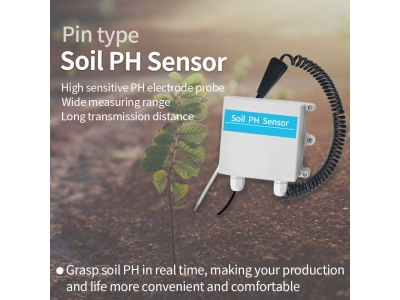Agriculture is an essential industry that sustains our growing global population. However, conventional farming practices often face challenges such as resource depletion, environmental degradation, and the need for sustainable solutions. In recent years, the advent of soil sensor innovations has revolutionized the agricultural landscape, enabling farmers to adopt sustainable farming practices. This article explores the concept of sustainable agriculture, the role of soil sensors in promoting sustainability, the types of soil sensors available, their applications, and the benefits they offer.
I. Understanding Sustainable Agriculture
Sustainable agriculture is a holistic approach to farming that aims to meet the demands of the present generation while preserving resources for future generations. It focuses on maintaining a balance between economic viability, environmental stewardship, and social responsibility. Sustainable farming practices prioritize soil health, water conservation, biodiversity preservation, and minimal reliance on synthetic inputs.
II. The Role of Soil Sensors in Promoting Sustainability
Soil sensors play a vital role in facilitating sustainable farming practices. By providing real-time data on key soil parameters, they empower farmers to make informed decisions regarding irrigation, fertilization, and crop management. By utilizing soil sensors, farmers can optimize resource usage, minimize waste, reduce environmental impact, and ensure the long-term health and productivity of their land.
III. Types of Soil Sensors

Soil Moisture Sensors: These sensors measure the moisture content in the soil, guiding farmers on when and how much to irrigate. By avoiding overwatering, water waste is minimized, and optimal soil moisture levels are maintained for plant growth.
Temperature Sensors: Temperature sensors monitor the soil temperature, allowing farmers to understand its impact on crop development. This information helps determine suitable planting times, manage heat stress, and optimize crop growth.
Nutrient Sensors: Nutrient sensors measure essential nutrients in the soil, such as nitrogen, phosphorus, and potassium. Monitoring nutrient levels helps farmers adjust their fertilization practices, avoiding overuse or underuse of fertilizers, and promoting efficient nutrient uptake by plants.
pH Sensors: pH sensors measure soil acidity or alkalinity, which is vital for nutrient availability and microbial activity. Maintaining proper soil pH is crucial for optimal plant growth, and pH sensors help farmers assess soil health and make necessary adjustments.
IV. Applications of Soil Sensors in Sustainable Farming
Precision Irrigation: Soil moisture sensors enable precise irrigation by providing real-time data on soil moisture levels. Farmers can automate irrigation systems to deliver water only when and where it is needed, reducing water waste and energy consumption.
Nutrient Management: By monitoring nutrient levels, farmers can optimize fertilizer application. Nutrient sensors help identify deficiencies or excesses, allowing for targeted and efficient use of fertilizers, reducing costs and minimizing environmental impact.
Disease and Pest Management: Soil sensor monitoring can provide early detection of soil-borne diseases and pests. Changes in soil moisture or temperature patterns may indicate the presence of pathogens or pests, enabling farmers to take prompt preventive measures and minimize crop losses.
Crop Planning and Optimization: Soil sensor data combined with other variables such as weather forecasts enables farmers to make informed decisions regarding crop selection, planting schedules, and yield optimization. This information improves resource allocation and enhances overall farm productivity.
V. Benefits of Soil Sensor Innovations
Resource Efficiency: Soil sensors enable farmers to optimize resource usage, including water, fertilizers, and energy. By providing real-time data, soil sensors minimize waste, reduce costs, and enhance resource efficiency.
Enhanced Crop Quality and Yield: Precise monitoring of soil parameters ensures crops receive optimal conditions for growth. This leads to improved crop quality, increased yields, and improved profitability for farmers.
Environmental Sustainability: Sustainable farming practices supported by soil sensors help protect natural resources, conserve water, minimize soil erosion, and reduce pollution from fertilizers and chemicals. This contributes to environmental sustainability and the preservation of ecosystems.
Data-driven Decision Making: Soil sensor data provides farmers with accurate and real-time information for decision making. By analyzing this data, farmers can make informed choices about crop management practices, leading to improved planning, increased productivity, and enhanced profitability.
VI. Future Directions and Advancements
The field of soil sensor innovations continues to progress, with ongoing advancements in sensor technology, connectivity, and data analytics. Some future directions and advancements include:
Integration with IoT and AI Technologies: Soil sensors can be integrated with the Internet of Things (IoT) and Artificial Intelligence (AI) technologies to create smart farming systems. This integration allows for automated data collection, analysis, and decision-making processes, increasing farming efficiency and sustainability.
Multi-Sensor Networks and Fusion Techniques: The development of multi-sensor networks and fusion techniques enables a comprehensive understanding of soil and environmental conditions. Combining data from various sensors provides deeper insights and improves the accuracy of farming decisions.
Wireless and Remote Monitoring: Advancements in wireless technology allow for remote monitoring of soil conditions, enabling farmers to access real-time data from anywhere. This facilitates timely decision-making and enhances farm management capabilities.
Advanced Data Analytics and Predictive Models: By leveraging advanced data analytics and predictive models, soil sensor data can be utilized for forecasting disease outbreaks, optimizing resource allocation, and improving overall farm performance. These analytical tools enable proactive management and risk mitigation strategies.
VII. Conclusion
Soil sensor innovations have been instrumental in transforming conventional farming practices into sustainable and efficient systems. By enabling real-time monitoring of soil parameters, these sensors empower farmers to make informed decisions, optimize resource usage, and minimize environmental impact. The benefits of soil sensor innovations include improved resource efficiency, enhanced crop quality and yield, environmental sustainability, and data-driven decision-making. As technology continues to advance, the integration of soil sensors with other technologies will further enhance the potential for sustainable agriculture, creating a greener and more resilient future for farming.






